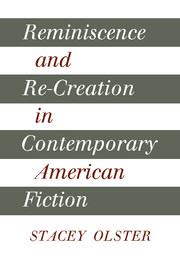Book contents
- Frontmatter
- Contents
- Preface
- Key to Abbreviations
- Reminiscence and Re-Creation in Contemporary American Fiction
- Introduction
- 1 A Disruption of Sensibility
- 2 The Transition to Post-Modernism: Norman Mailer and a New Frontier in Fiction
- 3 Thomas Pynchon: An Interface of History and Science
- 4 John Barth: Clio as Kin to Calliope
- Conclusion: “Subjective Historicism”
- Notes
- Bibliography
- Index
- PERMISSIONS
Conclusion: “Subjective Historicism”
Published online by Cambridge University Press: 19 March 2010
- Frontmatter
- Contents
- Preface
- Key to Abbreviations
- Reminiscence and Re-Creation in Contemporary American Fiction
- Introduction
- 1 A Disruption of Sensibility
- 2 The Transition to Post-Modernism: Norman Mailer and a New Frontier in Fiction
- 3 Thomas Pynchon: An Interface of History and Science
- 4 John Barth: Clio as Kin to Calliope
- Conclusion: “Subjective Historicism”
- Notes
- Bibliography
- Index
- PERMISSIONS
Summary
Your two eyes are an accurate stereoscopic camera, sure enough, but the process by which the upside down image on the retina takes effect on the brain entails a certain amount of unconscious selection. What you see depends to a great extent on subjective distortion and elimination which determines the varied impacts on the nervous system of speed of line, emotions of color, touch values of form. Seeing is a process of imagination.
–John Dos Passos, “Satire as a Way of Seeing” (1937)Seeing, to John Dos Passos, was also an imaginative process whose subjective components could be successfully tempered. Writing over twenty years later about the problems of finding “elbow room” within an increasingly bureaucratized society, he asserted the need for looking at American institutions with “fresh understanding, untrammeled by prejudice or partisan preconceptions, ” and advanced objective observation as the preferred means of discovery. “Observing objectively demands a sort of virginity of the perceptions, ” he explained. “A man has to clear all preconceived notions out of his head in a happy self-forgetfulness where there is no gap between observation and description.” In so falling into “the uneducated man's naive and ignorant frame of mind” and meeting each new phenomenon “with a clean slate as if you had never heard of it before, ” it was possible to “see things as they are, instead of as we were told they ought to be” (Occasions 72–3, 75).
- Type
- Chapter
- Information
- Reminiscence and Re-creation in Contemporary American Fiction , pp. 137 - 152Publisher: Cambridge University PressPrint publication year: 1989



